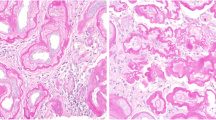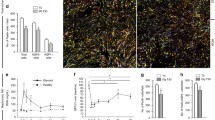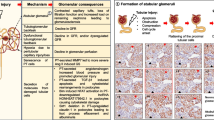Summary
Nephrotoxic drugs may account for approximately at least 20 % of clinically observed cases of acute renal failure in whom tubular lethal or sublethal damage is a predominant finding. Acute toxic tubular cell injury is characterized by loss of cellular polarization, intrinsic energy deficiency, calcium overload, release of toxic proteases and free oxygen radicals, derangement of the cytoskeleton, and vacuolar transformation of brush border microvilli. These events may finally lead to irreversible cell death.
Shedding of membrane enzymes and cytoskeletal components in urine (kidney tissue proteinuria) may serve as a noninvasive early marker for assessing tubular cell injury. Successful recovery of renal function depends on early repair of lethally or sublethally damaged nephrons, in which intrinsic nephrogenic adaptive and proliferative responses cooperate in concert with auto/para/-juxtacrine growth promoting factors and cytokines.
Exogenously administered growth factors may enhance renal cell recovery, as shown in animal models. Increased expression of immediate early genes in tubular cells after renal injury reflects the ongoing mitogenic activity necessary for reepithelialization and remodeling (new, polarized, differentiated cells).
Further progress in understanding the molecular mechanisms of renal tubular injury will probably influence the diagnostic modalities and therapeutic approaches to acute drug induced renal failure.
Similar content being viewed by others
References
Bach PH, Delacruz L, Gregg NJ, Wilks MF (1991) Nephrotoxicity: the basis for early diagnosis, modulation of effects and improved therapeutic management. Dekker, New York, Basel
Bennett WM, Elzinga LW, Porter GA (1991) Tubulointerstitial disease and toxic nephropathy. In: Brenner BM, Rector FC (eds) The Kidney. Saunders, Philadelphia, pp 1430–1496
Abuelo JG (1990) Renal failure caused by chemicals, foods, plants, animal venoms, and misuse of drugs-anoverview. Arch Int Med 150: 505–510
Ullrich KJ, Rumrich G, Gemborys MW, Dekant W (1991) Renal transport and nephrotoxicity. Guilford Press, pp 1–3
Solez K, Racusen LC (1991) Acute renal failure: diagnosis, treatment and prevention, Dekker, New York, Basel
Halabe A, Wong NLM, Sutton RAL (1991) Effect of chronic cisplatin administration on phosphate and glucose transport by the renal brush border membrane. Nephron 57: 197–200
Venkatachalam MA, Jones DB, Rennke HG, Sandstrom D, Patel Y (1981) Mechanism of proximal tubule brush border loss and regeneration following mild renal ischaemia. Lab Invest 45: 355–365
Paddock JK, Taddeo AR, Paddock JP, Loewenstein LM (1985) Glycoprotein reutilization in regenerating microvilli after renal ischaemia of rats. Kidney Int 28: 498–503
Toback FG (1992) Regeneration after acute tubular necrosis. Kidney Int 41: 226–246
Mondorf AW, Scherberich JE, Falkenberg FW et al. (1984) Brush border enzymes and drug nephrotoxicity. In: Solez K, Whelton A (eds) Acute renal failure. Dekker, New York, pp 281–292
Scherberich JE, Mondorf W, Falkenberg W, Pierard D, Schoeppe W (1984) Monitoring drug nephrotoxicity: quantitative estimation of human kidney brush border antigens in urine as a specific marker of tubular damage. Contr Nephrol 42: 81–92
Burchardt U, Scherberich JE (1992) Mechanisms of enzyme release and causes of altered enzyme excretion. In: Jung K, Mattenheimer H, Burchardt U (eds) Urinary enzymes in clinical and experimental medicine. Springer, Berlin, Heidelberg, New York, pp 21–42
Coudrier B, Kerjaschki D, Louvard D (1988) Cytoskeleton organization and submembranous interactions in intestinal and renal brush border. Kidney Int 34: 309–320
Fischer P, Scherberich JE, Schoeppe W (1990) Comparative biochemical and immunological studies on gamma-glutamyltransferases from human kidney and renal cell carcinoma applying monoclonal antibodies. Clin Chim Acta 191: 185–200
Look AT, Ashmun RA, Shapiro LH, Peiper SC (1989) Human myeloid plasma membrane glycoprotein CD13 (gp 150) is identical to aminopeptidase N. J Clin Invest 83: 1299–1307
Kenny AJ, O'Hare MJ, Gusterson BA (1989) Cell-surface peptidases as modulators of growth and differentiation. Lancet II: 785–787
Wolf G, Scherberich JE, Schoeppe W (1988) Peptidase- associated antigens as markers of differentiation in human kidney and renal adenocarcinoma. Cell Melee Biol 3: 311–321
Wolf G, Scherberich JE. Schoeppe W (1989) Glomeruli isolated from human kidney split angiotensin II: further evidence that renal “aminopeptidase A” (APA) is an angiotensinase. Fresenius' Zeitschr Anal Chem: 330, 429–430
Herzig C, Schoeppe W, Scherberich J (1992) Angiotensinase A: properties of chromatographically purified isoforms from human kidney. J Chromatogr 625: 73–82
Tolkoff-Rubin NE, Thompson RE, Piper DJ et al. (1987) Diagnosis of renal proximal tubular injury by urinary immunoassay for a proximal tubular antigen, the adenosine-deaminase binding protein. Nephrol Dial Transplant 2: 143–148
Nosaka K, Nakada J, Endou H (1992) Cisplatin-induced alterations in renal structure, ammoniagenesis and gluconeogenesis of rats. Kidney Int 41: 73–79
Ullrich KJ, Rumrich G, Klöss S (1989) Contraluminal organic anion and cation transport in the proximal renal tubule: V Interaction with sulfamoyl- and phenoxy diuretics, and with β-lactam antibiotics. Kidney Int 36: 78–88
Yoshioka T, Fogo A, Beckman JK (1992) Reduced activity of antioxidant enzymes underlies contrast media-induced renal injury in volume depletion. Kidney Int 41: 1008–1015
Joly V, Saint-Pierre-Chazalet M, Saint Julien L, Bolard J, Carbon C, Yeni P (1992) Inhibiting cholesterol synthesis reduces the binding and toxicity of amphotericin B against rabbit renal tubular cells in primary culture. J Infect Dis 165: 337–343
Molitoris BA, Nelson WJ (1990) Alterations in the establishment and maintenance of epithelial cell polarity as a basis for disease processes. J Clin Invest 85: 3–9
Scherberich JE (1989) Immunological and ultrastructural analysis of loss of tubular membrane-bound enzymes in patients with renal damage. Clin Chim Acta 185: 271–282
Scherberich JE (1990) Urinary proteins of tubular origin; basic immunochemical and clinical aspects. Am J Nephrol 10 [Suppl 1]: 43–51
Scherberich JE, Rautschka E, Fischer A, Kollath J, Riemann HE (1990) Tubular histuria: clinical evaluation of the different nephrotoxic potential of x-ray contrast media. Contr Nephrol 83: 229–236
Scherberich JE, Wiemer J, Herzig C, Fischer P, Schoeppe W (1990) Isolation and partial characterization of angiotensinase A and aminopeptidase-M from urine and human kidney using lectin affinity chromatography and high preformance liquid chromatography. J Chromatogr 521: 279–289
Scherberich JE, Wiemer J, Schoeppe W (1991) Biochemical and immunological properties of urinary angiotensinase A and dipeptidylaminopeptidase IV Their use as markers in patients with renal cell injury. Eur J Clin Chem Clin Biochem 30: 663–668
Sachse HJ, Falkenberg FW, Scherberich JE et al. (1981) Development of a radioimmunoassay for a high molecular mass tubular antigen in urine- its application for early detection of tubular damage. Clin Chim Acta 110: 91–104
Heinert G, Wyrobnik J, Scherberich JE (1980) Quantitative computed histophotometry of membrane-integrated and lysosomal enzymes indicating inductive and alterative effects of aminoglycosides. Curr Chemother Immunother 11: 252–254
Wallin A, Zhang G, Jones TW, Jaken S, Stevens JL (1992) Mechanism of the nephrogenic repair response. Lab Invest 66: 474–484
Scherberich JE, Wolf G, Albers C, Nowack A, Stuckhardt C, Schoeppe W (1989) Glomerular and tubular membrane antigens reflecting cellular adaptation in human renal failure. Kidney Inter 36 [Suppl 27]: S38-S51
Wolf G, Thaiss F, Scherberich JE, Schoeppe W, Stahl RAK (1990) Glomerular angiotensinase A in the rat: increase of enzyme activity following renal ablation. Kidney Int 38: 862–868
Wolf G, Neilson EG (1991) Molecular mechanisms of tubulointerstitial hypertrophy and hyperplasia. Kidney Int 39: 401–420
Gröne H-J, Weber K, Gröne E, Helmchen U, Osborn M (1987) Coexpression of Keratin and Vimentin in damaged and regenerating tubular epithelia of the kidney. Am J Path 129: 1–8
Toback FG, Walsh-Reitz MM, Kartha S (1991) Signals that release growth factors from renal epithelial cells. Am J Kidney Dis 27: 622–626
Murray W, Kirschner MW (1989) Dominoes and clocks: the union of two views on the cell cycle. Science 246: 614–621
Nurse P (1990) Universal control mechanism regulation onset of M-phase. Nature 344: 503–508
Siegel N, Gaudio KM, Katz LA, Reilly HF, Ardito TA, Hendler FG, Kashgarian M (1984) Beneficial effect of thryroxin on recovery from toxic acute renal failure. Kidney Int 25: 906–911
Wolf G, Neilson EG (1992) Increases in levels of collagen types I and IV messenger ribonucleic acid in murine kidneys after treatment with ciclosporin. Nephron 60: 87–91
Segal R, Fine LG (1989) Polypeptide growth factors and the kidney Kidney Int 36 [Suppl 27]: S2-S10
Bacallao R, Fine LG (1989) Molecular events in the organization of renal tubular epithelium: from nephrogenesis to regeneration. Am J Physiol 257: 17913–17924
Wolf G, Neilson EG (1990) Angiotensin II induces cellular hypertrophy in cultured murine proximal tubular cells. Am J Physiol 259: F768-F1195
Wolf G, Killen PD, Neilson EG (1991) Intracellular signalling of transcription and secretion of type IV collagen after angiotensin II-induced cellular hypertrophy in cultured proximal tubular cells. Cell Regulation 2: 219–227
Humes DH, Beals TF, Cieslinski DA, Sanchez I, Page TP (1991) Effects of transforming growth factor-ß, TGF-a, and other growth factors on renal proximal tubule cells. Lab Invest 64: 538–545
Coimbra T, Cieslinski DA, Humes D (1990) Epidermal growth factor accelerates renal repair in mercuric chloride nephrotoxicity. Am J Physiol 259: F438-F448
Nonclerq D, Toubeau G, Lambricht P, Heuson-Stiennon J-A, Laurent G (1991) Redistribution of epidermal growth factor immunoreactivity in renal tissue after nephrotoxin-induced tubular injury. Nephron 57: 210–215
Wolf G, Neilson EG (1993) Angiotensin-II as a hypertrophogenic cytokine from proximal tubular cells. Kidney Int [Suppl] 39: S100-S107
Author information
Authors and Affiliations
Rights and permissions
About this article
Cite this article
Scherberich, J.E., Wolf, G. & Schoeppe, W. Shedding and repair of renal cell membranes following drug-induced nephrotoxicity in humans. Eur J Clin Pharmacol 44 (Suppl 1), S33–S38 (1993). https://doi.org/10.1007/BF01428390
Issue Date:
DOI: https://doi.org/10.1007/BF01428390




